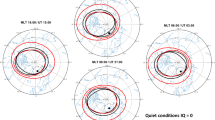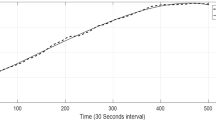Abstract
IONOSPHERIC measurements at the Royal Society Base at Halley Bay (75° 31′ S. 26° 36′ W. geomagnetic latitude 65° 47′ S.) started on April 1, 1957, and some results for the first year's operation are now available. The Base lies in the zone where the magnetic dip is abnormally small (65°) considering the high latitude and the general ionospheric variations are found to be remarkably regular.
This is a preview of subscription content, access via your institution
Access options
Subscribe to this journal
Receive 51 print issues and online access
$199.00 per year
only $3.90 per issue
Buy this article
- Purchase on Springer Link
- Instant access to full article PDF
Prices may be subject to local taxes which are calculated during checkout
Similar content being viewed by others
References
Cox, J. W., and Davies, K., Canad. J. Phys., 32, 743 (1954).
Agy, V., J. Geophys. Res., 59, 499 (1954).
Author information
Authors and Affiliations
Rights and permissions
About this article
Cite this article
BELLCHAMBERS, W., PIGGOTT, W. Ionospheric Measurements made at Halley Bay. Nature 182, 1596–1597 (1958). https://doi.org/10.1038/1821596a0
Issue Date:
DOI: https://doi.org/10.1038/1821596a0
This article is cited by
-
Thermospheric parameters contribution to the formation of Yakutsk F2-layer diurnal summer time anomaly
Scientific Reports (2022)
-
Variability of Ionospheric Plasma: Results from the ESA Swarm Mission
Space Science Reviews (2022)
-
Retrospect and prospect of ionospheric weather observed by FORMOSAT-3/COSMIC and FORMOSAT-7/COSMIC-2
Terrestrial, Atmospheric and Oceanic Sciences (2022)
-
Simulated east–west differences in F-region peak electron density at Far East mid-latitude region
Earth, Planets and Space (2020)
-
Nighttime anomaly of ionospheric electron density
Science China Earth Sciences (2016)
Comments
By submitting a comment you agree to abide by our Terms and Community Guidelines. If you find something abusive or that does not comply with our terms or guidelines please flag it as inappropriate.



